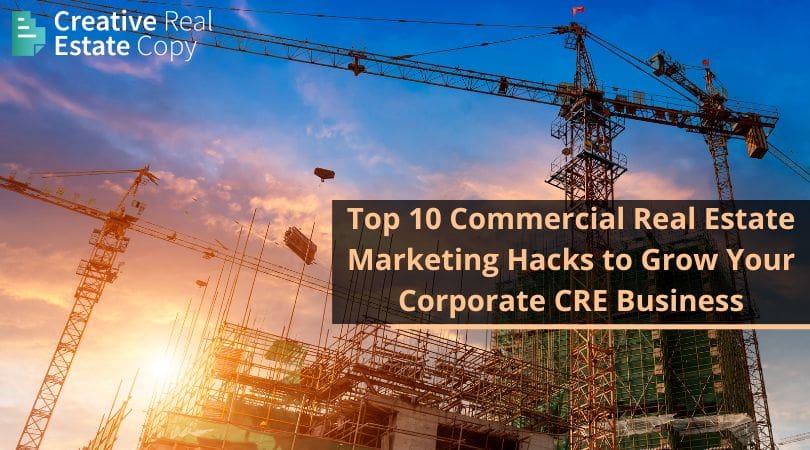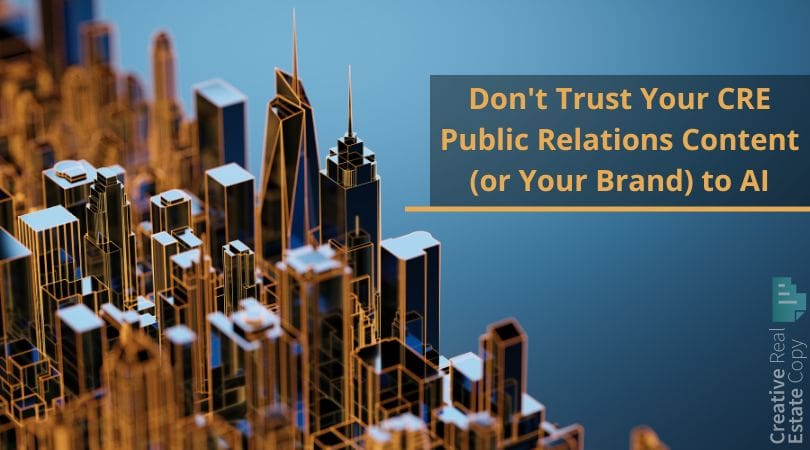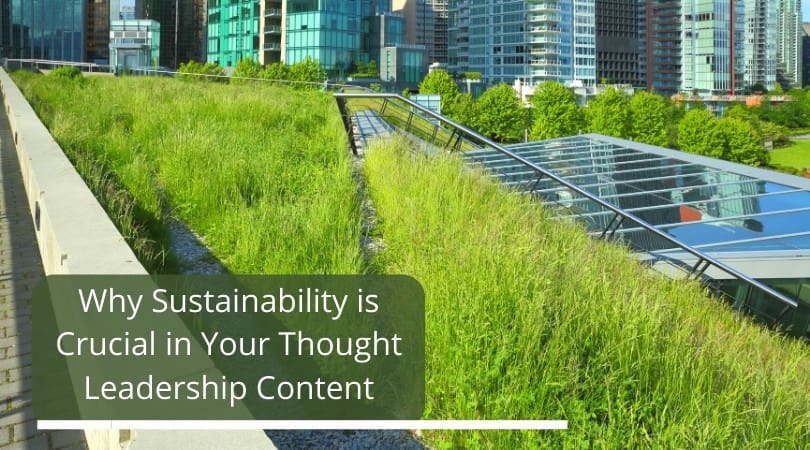What sets the most successful commercial real estate firms apart?
It’s not their ability to follow trends but their capacity to shape and lead them. In a crowded market, distinction comes from becoming a thought leader.
“Thought Leadership” isn’t a fashionable cliché.
It’s a prudent and legitimate strategic investment in developing and sharing your expertise and innovative thinking. It positions your company as a pioneer, driving growth and establishing lasting influence.
Consistently providing valuable insights and forward-thinking solutions helps build a reputation that attracts high-quality clients and fosters enduring relationships. Embracing thought leadership transforms your brand into a respected authority, ensuring you stand out in the industry for all the right reasons.
Let’s look closer at why this is important and how to position your brand and executives as credible sources of insight and precipitate enthusiastic conversations with prospects and current stakeholders.
Why thought leadership matters
Establishing credibility
By sharing valuable insights and expertise, you position your company as a leader in the industry. This builds trust with clients, partners, and stakeholders, making your firm the go-to resource for industry knowledge.
Driving innovation
Thought leadership encourages continuous learning and innovation. You drive your company’s growth and adaptability by staying ahead of industry trends and pioneering new ideas. Leading from the edge is crucial in an industry where technology and market dynamics constantly evolve.
Enhancing brand visibility
Consistent thought leadership content amplifies your brand’s presence in the market. You reach a broader audience and enhance your company’s reputation through articles, white papers, webinars, and speaking engagements. Visibility ensures you’re recognized as a leader and pioneer in the industry.
Fostering relationships
Thought leadership involves more than sharing your ideas; it focuses on actively engaging with your audience. You build stronger relationships and foster a community around your brand by sparking conversations and inviting feedback. Engagement creates a sense of loyalty and trust that traditional marketing struggles to achieve.
Creating long-term value
Investing in thought leadership creates lasting value. It shapes your company’s narrative, influences industry standards, and drives sustainable growth by continuously attracting new opportunities and talent and delivering better outcomes for your stakeholders. Thought leadership builds a legacy, ensuring your company remains influential and relevant for years.
Why traditional marketing falls short
In the mature and competitive CRE market, traditional marketing approaches often don’t provide the results we need to achieve long-term growth and stability. Conventional advertising might reach a broad audience but lacks the depth and engagement that today’s sophisticated clients expect. In contrast, thought leadership-oriented marketing provides substance and value, offering meaningful insights that resonate with your target audience.
Generic ads
Traditional marketing often relies on generic ads that fail to differentiate your brand. Thought leadership lets you showcase your unique perspective and expertise, setting you apart from competitors. Instead of blending in and being perceived as a commodity, you stand out as a thought leader who brings unique, fresh ideas and innovative solutions.
One-way communication
Traditional marketing tends to be unilateral, pushing messages out without engaging the audience. Thought leadership fosters a two-way conversation, encouraging interaction and feedback. Dialogue enhances engagement and provides valuable insights into your audience’s needs and preferences.
Short-term focus
Sales-oriented marketing strategies typically focus on short-term gains, like quick clicks and impressions. Thought leadership builds long-term relationships and trust, leading to sustained growth and loyalty. Your audience begins to see you as a partner in their journey, not just a vendor.
The power of thought leadership in CRE marketing
As a CRE executive, you always seek ways to drive more interest, traffic, leads, and new clients. Thought leadership can be your most powerful tool in achieving these goals.
Attracting high-quality leads
You attract genuinely interested prospects to your services and products by sharing valuable insights and expertise. These high-quality leads are more likely to convert into loyal clients. They come to you with a clear understanding of your value proposition and a strong belief in your capabilities.
Increasing engagement
Innovative ideas and actionable content are inherently engaging. They spark discussions, encourage sharing, and keep your audience returning for more. Continuous engagement builds a loyal community around your brand, amplifying your reach and impact.
Driving organic growth
Thought leadership content is highly shareable, driving organic growth through word-of-mouth and social media. Your audience becomes your brand ambassadors, spreading your message throughout the industry. Organic growth is more sustainable and cost-effective than conventional advertising.
Building connections through thought leadership
One of the most significant benefits of thought leadership is building deep connections with your audience. The best prospects and clients are those who feel like they know you and trust you based on the content and insights you create and share.
Creating a sense of familiarity
When you consistently share valuable insights, your audience feels familiar with your brand. They see your content regularly, hear your voice, and become accustomed to your perspectives. This familiarity breeds comfort and trust.
Demonstrating expertise
Conveying insights allows you to demonstrate your expertise in a way that traditional marketing can’t. By addressing industry challenges, offering solutions, and providing unique insights, you show your audience that you understand their needs and have the knowledge to help them succeed.
Engaging through owned and earned media
Thought leadership thrives on both owned and earned media channels. Owned media, such as your blog, website, and social media platforms, allows you to control your message and build a direct relationship with your audience. Earned media (PR), including guest articles, speaking engagements, and media coverage, enhances your credibility and reach by leveraging third-party endorsements.
Actionable steps to embrace thought leadership
To harness the power of thought leadership, integrate it into your marketing strategy with these actionable steps:
Content creation
Regularly publish insightful content that addresses industry challenges and offers innovative solutions. This includes blogs, case studies, white papers, and research reports. Ensure your content is well-researched, relevant, and provides real value to your audience.
Public speaking
Participate in industry conferences, webinars, and panels to share your expertise and connect with peers. Speaking engagements allow you to reach new audiences and establish your presence as an industry thought leader.
Collaborations
Partner with other industry leaders and organizations to co-create content and host events, amplifying your reach and impact. Collaborative efforts bring fresh perspectives and enhance your credibility.
Social media engagement
Use social media platforms to share insights, engage with your audience, and stay connected with industry developments. Social media allows you to interact directly with your target market, fostering a sense of community and rapport.
Continuous learning
Stay updated with industry trends, technologies, and best practices to ensure your thought leadership remains relevant and impactful. Thought leadership is a continuous journey of learning and sharing knowledge.
Making the shift: From ads to thought leadership
Transitioning from traditional marketing to thought leadership-oriented strategies requires a mindset shift: prioritizing value over volume and relationships over transactions.
Understand your audience
Know what challenges your audience faces and what insights they value. Tailor your content to address their specific needs and interests. The more you understand your audience, the more effectively you can engage them.
Be consistent
Thought leadership requires consistency. Regularly share high-quality content to build and maintain your authority. Consistency builds trust and keeps your audience engaged over the long term.
Engage authentically
Authenticity is inherent to thought leadership. Share your genuine insights and experiences, and be open to feedback and dialogue. Authenticity fosters trust and makes your content more relatable and impactful.
Measure impact
Track the impact of your thought leadership efforts using metrics like engagement rates, lead quality, and client feedback to refine your strategy and demonstrate its value. Measuring results helps you understand what works and where you can improve.
An investment in growth
Thought leadership is more than a marketing strategy; it’s a commitment to excellence and growth. Investing in thought leadership positions your company as an authority, drives innovation, and builds lasting relationships with your clients and other stakeholders.
Embrace the power of thought leadership to be heard, respected, and chosen. Your investment in thought leadership now will pay dividends in growth, influence, and success for years.






 Creative Real Estate Copy
Creative Real Estate Copy